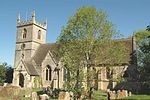Blenheim Palace ( BLEN-im) is a country house in Woodstock, Oxfordshire, England. It is the seat of the Dukes of Marlborough and the only non-royal, non-episcopal country house in England to hold the title of palace. The palace, one of England's largest houses, was built between 1705 and 1722, and designated a UNESCO World Heritage Site in 1987.The palace is named after the 1704 Battle of Blenheim. It was originally intended to be a reward to John Churchill, 1st Duke of Marlborough for his military triumphs against the French and Bavarians in the War of the Spanish Succession, culminating in the Battle of Blenheim. The land was given as a gift, and construction began in 1705, with some financial support from Queen Anne. The project soon became the subject of political infighting, with the Crown cancelling further financial support in 1712, Marlborough's three-year voluntary exile to the Continent, the fall from influence of his duchess, and lasting damage to the reputation of the architect Sir John Vanbrugh.
Designed in the rare, and short-lived, English Baroque style, architectural appreciation of the palace is as divided today as it was in the 1720s. It is unique in its combined use as a family home, mausoleum and national monument. The palace is notable as the birthplace and ancestral home of Sir Winston Churchill.
Following the palace's completion, it became the home of the Churchill (later Spencer-Churchill) family for the next 300 years, and various members of the family have wrought changes to the interiors, park and gardens. At the end of the 19th century, the palace was saved from ruin by funds gained from the 9th Duke of Marlborough's marriage to American railroad heiress Consuelo Vanderbilt.









